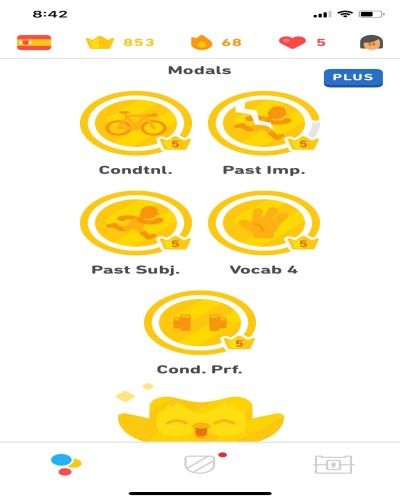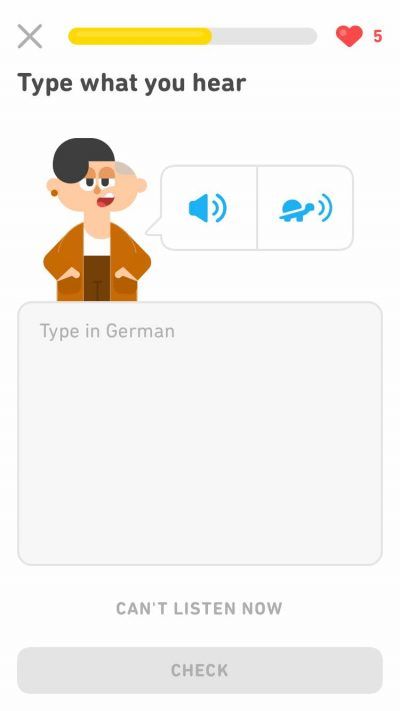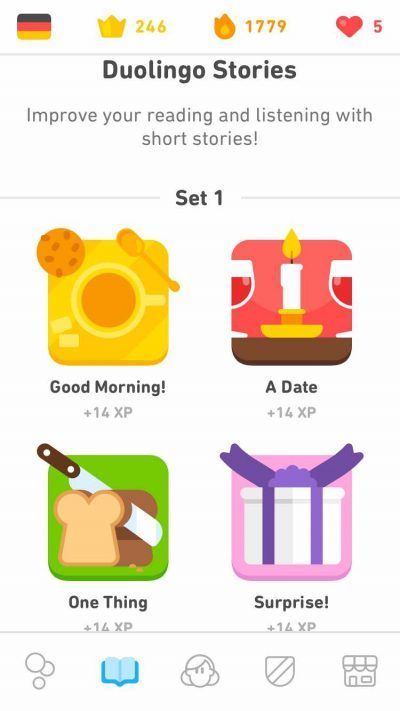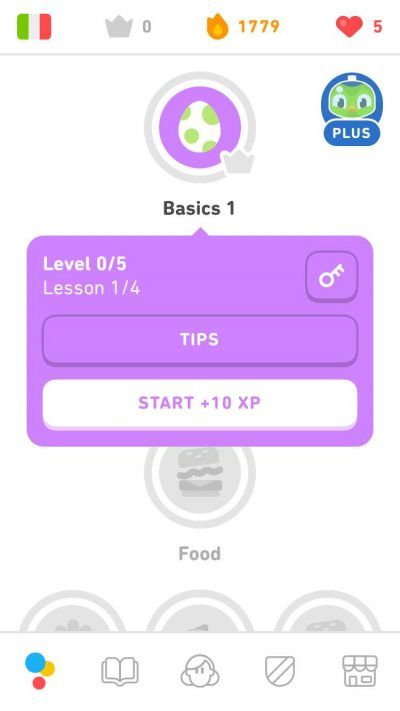Duolingo Review – How It Works, And Is It Effective
PLEASE NOTE: This review is outdated and applies to the old version of Duolingo, which changed in November 2022.
When it comes to useful language learning apps that are also free, Duolingo is up there with the best of them. You can easily go from absolute beginner to getting a real foundation in a brand new language, and do so in an entertaining, addictive way, all from the comfort of your smartphone, tablet or pc/laptop.
By combining education, fun and community, Duolingo has amassed millions of users since its creation in 2011. They claim to have a whopping 300 million learners from all walks of life, so they’ve used their data to devise the most effective language learning app.
What languages are available on Duolingo?
For English speakers, there are currently 36 language courses.
| EUROPEAN | Spanish, French, German, Italian, Romanian, Portuguese, Latin, Dutch, Swedish, Danish, Norwegian, Finnish, Hungarian, Irish, Scottish Gaelic, Welsh, Polish, Czech, Greek, Russian, Ukrainian, Turkish |
| ASIAN | Japanese, Korean, Mandarin Chinese, Hindi, Vietnamese, Indonesian |
| AFRICAN/MIDDLE EASTERN | Swahili, Arabic, Hebrew |
| AMERICAN | Hawaiian, Navajo |
| CONSTRUCTED | Esperanto, Klingon, High Valyrian |
The most popular course is Spanish for English speakers, with over 28 million learners. According to this wiki, Norwegian, with 590 lessons, is the longest course on Duolingo, though new lessons are regularly added to other languages.
Courses are created by native-speaking volunteers. New ones are added depending on how many people are available to build a course, and how much interest there is in a language.
You cannot use the app offline unless you have Duolingo Plus, which costs $6.99 a month. There is a 14-day free trial to Plus, which you can try to see if the added benefits are worth it. It should be noted, though, that you get exactly the same lessons in the regular app as you do in Plus – there is zero difference.
So, how does Duolingo work?
Goal setting
Once you choose a course, you’re asked to set goals on how much time you wish to spend learning per day. You have 4 options: Casual (5 mins), Regular (10 mins), Serious (15 mins), and Intense (20 mins).
You can change this at any time to suit your daily needs. I would suggest setting a goal that’s achievable and not a chore, so that you don’t get overwhelmed and quit altogether.
Choosing and starting a course
You can learn as many languages as there are available on Duolingo; there is no limit.
When you first start, you’ll be asked if you’re a beginner or if you have some knowledge of the language. If you select the former, you start from scratch; the latter, you are given a Placement Test to assess your level. Once completed, depending on how you do, you will be moved to a more advanced, later section of the course.

Let’s assume that you’re an absolute beginner. From the very first lesson, you’re thrown straight into the language, learning the basics – simple but useful words. It’s fun and easy, and, having completed these early lessons, you’ll get a sense of achievement.
This will keep you inspired and enticed to do more. You might even be tempted to speed through, thinking you’ll remember and retain everything. But don’t! You need to take your time and process what you’ve learnt. You will forget things very quickly if you don’t keep going over the lessons.
How the courses are set up
Each one is divided into units, which increase in difficulty the more you learn. Within the units there are individual modules, or skills – in the form of eggs – that each contain anywhere from 1 – 9 lessons. These modules focus on different areas of the language – numbers, family, present tense etc.
Once you complete a skill, new skills become available. You should only move on to them once you’re comfortable with the earlier ones, as subsequent lessons will build upon what you’ve already learned.
There are 5 levels to each egg. After you pass the first level, subsequent ones get harder. In order to complete the whole course, you will need to reach level 5 on all eggs in all modules.
This should take you about 1 1/2 years, depending on the language you choose and how often you study. The romance languages (Spanish, Portuguese, Italian, French and Romanian) and Scandinavian ones (Swedish, Danish, and Norwegian) will likely take you a shorter time.
Reaching level 5 on skill eggs turns them gold; and once that happens to all of them, you will have achieved the coveted “golden tree”, signifying your completion of the entire course. You can still go back and repeat lessons whenever you want, but they will no longer get harder.

For languages that use a different alphabet/writing system than the Latin/Roman one, the first lessons will be spent familiarizing you with them and their sounds. This is important at the beginning, as you won’t really be able to progress without mastering the new alphabets or symbols.
What skills are honed, and how? What does Duolingo teach you?
You will gain all-round knowledge and practice in the 4 language skills – reading, writing, listening, and speaking, through a combination of exercises in each lesson.
Reading and writing
You either read a sentence in the target language then write out the English translation from scratch, or choose the answer from multiple choice words/sentences. Pictures are included when introducing new nouns, to help you along.

It also works the other way round; read a sentence in English, then write the translation in the target language.
Listening
You’ll be listening throughout most of the lessons, even during the reading exercises, as audio is included with many of them. But specific listening exercises focus on you hearing a sentence then either choosing its English equivalent, or writing what you hear in the target language.

The first recording you hear will be at normal speed, but there is a button to repeat at a much slower speed, where each word is pronounced clearly and succinctly. You can replay as many times as you like.
Speaking
You will get the opportunity to test your pronunciation in these exercises by reading out a sentence in the target language. The microphone on your device, if activated, will pick up your speech. If your pronunciation is good, you will move on. If not, you will have to keep saying it until you get it right.
Extra listening lessons – Duolingo Stories
Currently 5 languages (Spanish, Italian, Portuguese, French and German) include an extra section called Duolingo Stories. There are over 100 interesting, interactive short stories that you work through, filling in the blanks. The stories get harder and more in-depth as you progress. These are a great way to improve your listening and comprehension skills. They usually end in funny punchlines.

Making mistakes
You are allowed to make up to 5 mistakes before your hearts run out and you are chucked out of the lesson. Once your hearts are down to zero, to get more you have a number of options: do practice lessons; watch video ads; or refill them by spending 350 of the gems you’ve earned throughout the course. There is also the option of upgrading to the paid version of the app, which has unlimited hearts.

Note: Running out of hearts in just one lesson is a clear indication that you need more practice in earlier lessons. You should go over them before moving on.
Lesson Tips
Modules come with vital grammar explanations that are crucial to your understanding of the language. Unfortunately, most of these are only available on the desktop version of the program. Some European languages include them on the app, under Tips. Where you can, you should read all of these before you start each module.

Social
Luckily, where tips are not included, there are a number of helpful users in the Discussion section of every exercise, who have answered user questions about difficult points of grammar. If something is confusing you, it’s likely that someone has asked about it there, and it has been answered and explained by natives.
 You can only pose your own questions on the desktop version, not through the app, though you can read and up/down vote in-app.
You can only pose your own questions on the desktop version, not through the app, though you can read and up/down vote in-app.
Outside of the lessons, there is a very active forum for all of the languages provided, where users discuss everything about the language. This can only be accessed via the desktop version.
You can follow other users easily, and they can follow you. You will then see information about how much/how little they’ve been studying compared to you. Follow people who use the app frequently, as this will inspire you to do more.


